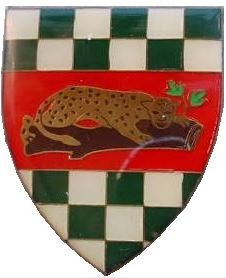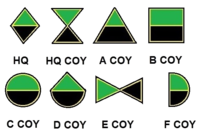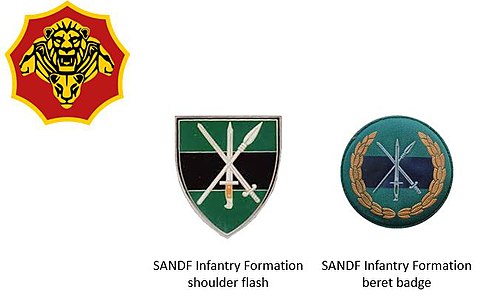
The First Boer War, was fought from 16 December 1880 until 23 March 1881 between the United Kingdom and Boers of the Transvaal. The war resulted in a Boer victory and eventual independence of the South African Republic. The war is also known as the First Anglo–Boer War, the Transvaal War or the Transvaal Rebellion.

The Cape Town Highlanders is a reserve mechanised infantry regiment of the South African Army.

The Bambatha Rifles is a reserve mechanised infantry regiment of the South African Army.

The Chief Langalibalele Rifles is a reserve infantry regiment of the South African Army.

The Buffalo Volunteer Rifles (BVR) is an infantry regiment of the South African Army. As a reserve unit, it has a status roughly equivalent to that of a British Army Reserve or United States Army National Guard unit.

The Chief Maqoma Regiment is a reserve infantry regiment of the South African Army. The regiment is located in the city of Port Elizabeth.

The General Jan Smuts Regiment is a reserve mechanised infantry regiment of the South African Army.

The Johannesburg Light Horse Regiment, is a reserve armoured car reconnaissance unit of the South African Army.

The Queen Nandi Mounted Rifles is an reserve armoured regiment of the South African Army.

The Nelson Mandela Artillery Regiment is a reserve artillery regiment of the South African Army and part of the South African Army Artillery Formation.

The Autshumato Anti-Aircraft Regiment is a reserve air defence artillery regiment of the South African Army.
South Africa has a number of Traditional Regiments. These are mostly South African Army Reserve Force regiments that were established either under previous colonial governments or by the Apartheid regime and which have continued to exist by accepting the authority of the government-of-the-day - be it colonial, union, Apartheid, or fully democratic.
The Cape Mounted Riflemen were South African military units.
The Cape Colonial Forces (CCF) were the official defence organisation of the Cape Colony in South Africa. Established in 1855, they were taken over by the Union of South Africa in 1910, and disbanded when the Union Defence Forces were formed in 1912.
Colonel Zachary Stanley Bayly, (1841–1916) was a South African colonial military commander. He was commissioned in the British Army, and was stationed in the Cape Colony from 1877.

The Cape of Good Hope General Service Medal is a British campaign medal which was awarded to members of the Cape Colonial Forces who took part in three campaigns in and around the Cape of Good Hope, in Basutoland in 1880–1881, in Transkei in 1880–1881 and in Bechuanaland in 1896–1897.

The Chief Makhanda Regiment is a reserve air assault infantry regiment of the South African Army.

The following battle honours were awarded to units of the British Army and the armies of British India and the Dominions of the British Empire. From their institution until the end of the Second World War, awards were made by, or in consultation with, the British government, but, since 1945, the individual countries of the former British Empire have awarded battle honours to their forces independently.
The Cape Mounted Police was the principal law enforcement agency of the Cape Colony during its last three decades. In addition to its ordinary policing duties, it was a para-military organisation, which saw active service in several campaigns and operations, including the Anglo-Boer War (1899–1902). The force was fully militarised in 1913 and transferred to the new South African Army as a mounted rifle regiment.



















